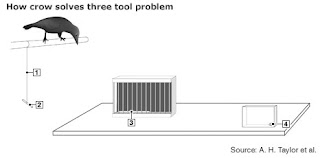The manufacture of tools
is a rare finding in the animal kingdom.
The New Caledonian Crow is
showing scientists that, not only can they use tools to aid in foraging, but
they are changing and making slight adjustments in the tool design.
Abel with stick
tool
The New Caledonian Crows
construct distinct types of tools to aid in foraging for invertebrates (bugs
and grubs) in trees. In a study
conducted by the Behavioural Ecology Research Group from Oxford University headed by Professor Alex Kacelnik they were
observed modifying and even manufacturing tools. The study showed that they can modify and make a new tool
with just about any material to solve new problems.
Betty-with a wire she has bent when she found the straight wire would not work
This tool modification is
something that has not been found in any other species than humans, but the new
Caledonian Crow has shown that there have been advances in foraging tool
design.
Betty raising the tub from the well with a wire she has bent
Scientists say most of the tools they find are simple one step
designs, but there are areas on the island where there are individual birds
making multi-step tools--up to as many as 50 steps! The biggest advancements are
the addition of a hooked or pointed end to help secure prey.
In the more controlled
setting of the laboratory the New Caledonian Crow has excelled with many
different challenges that scientists have thrown at them.
Diagram of the multi-stage challenge
1. String is attached to perch
2. Short stick attached to string
3. Long stick out of reach behind bars - can be reached with short stick
4. Out of reach scrap of meat - can be reached by long stick
1. String is attached to perch
2. Short stick attached to string
3. Long stick out of reach behind bars - can be reached with short stick
4. Out of reach scrap of meat - can be reached by long stick
A different research group
from the University of Auckland in New Zealand created a more difficult problem
for the Crows. One of the most
intriguing tasks set out for them was a multi-stage challenge. The challenge was to pull up a string
that had a small stick attached to it.
The crow then had to remove the small stick and use it to retrieve a
larger stick in the back of a slatted box. Finally, the Crow had to use the larger stick to retrieve
the reward in a long narrow box. Without hesitation the crow started
investigating the components to retrieve the reward and within 60 seconds the
crow started to pull up the string to start the sequence of events to the
reward.
The New Caledonian Crow is
a highly social, innovative, and persistent creature that is capable of much
more than we ever thought possible in an animal. To see some video clips of the
amazing problem solving abilities of these remarkable birds Click Here.
As a follow-up to their
laboratory study the research team has begun a field study that, among other
things, has attached a miniature camera to wild Crows on the island. These
cameras are attached to two central tail feathers, with the lens bent forward
peeking through the subjects' legs to provide a "crow's-eye view" of
the world (see photos).
Wild Crows with “Crow Cams”
The true test to this
whole idea that crows are tweaking tools to make them better is time. With the passing of time we should see
advancements in efficiency of the tools and also see a decline in the use of
old or obsolete tools.
Submitted by Adam Triska,
World Bird Sanctuary Field Studies Coordinator
Bird photos published by permission of Professor Alex Kacelnik, Behavioural Ecology Research Group
Bird photos published by permission of Professor Alex Kacelnik, Behavioural Ecology Research Group









No comments:
Post a Comment